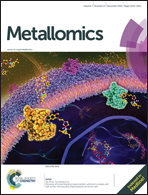Mechanistic evaluation of translocation and physiological impact of titanium dioxide and zinc oxide nanoparticles on the tomato (Solanum lycopersicum L.) plant†
Abstract
Sustainable use of nanotechnology for agricultural practice requires an understanding of the plant's life cycle and potential toxicological impacts of nanomaterials. The main objective of this study was to compare the impact of TiO2 and ZnO nanoparticles of similar size (25 ± 3.5 nm) over a range of concentrations (0 to 1000 mg kg−1) on translocation and accumulation of nanoparticles in different plant sections; as well as to establish physiological impact on tomato plants. The results indicated that there is a critical concentration of TiO2 and ZnO nanoparticles upto which the plant's growth and development are promoted; with no improvement beyond that. Aerosol mediated application was found to be more effective than the soil mediated application on the uptake of the nanoparticles was in plants. A mechanistic description of nanoparticle uptake, translocation and resultant plant response is unraveled. The present investigation demonstrates the concept of nanoparticle farming by understanding plant – nanoparticle interaction and biodistribution.

- This article is part of the themed collection: Zinc in the Biosciences


 Please wait while we load your content...
Please wait while we load your content...